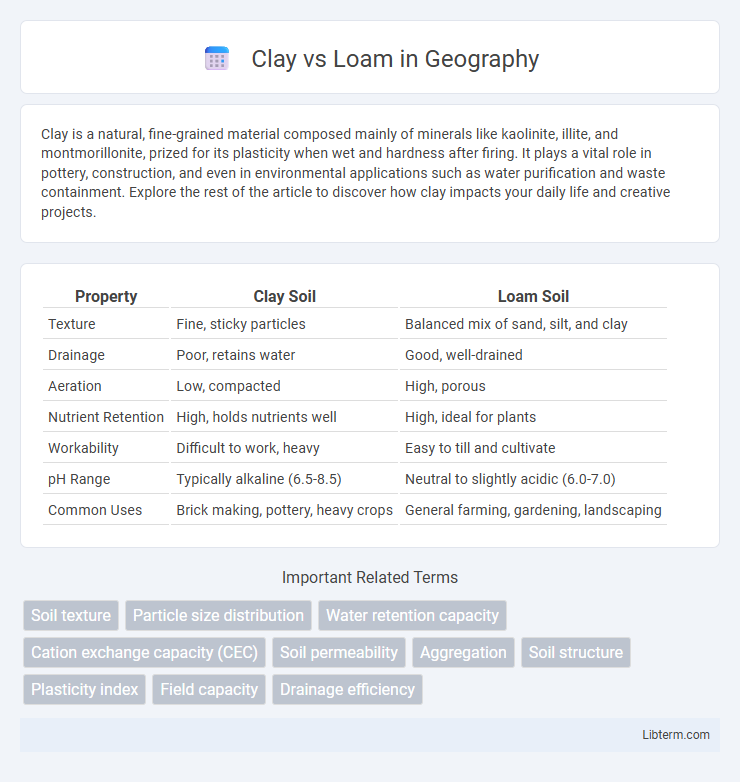Clay is a natural, fine-grained material composed mainly of minerals like kaolinite, illite, and montmorillonite, prized for its plasticity when wet and hardness after firing. It plays a vital role in pottery, construction, and even in environmental applications such as water purification and waste containment. Explore the rest of the article to discover how clay impacts your daily life and creative projects.
Table of Comparison
| Property | Clay Soil | Loam Soil |
|---|---|---|
| Texture | Fine, sticky particles | Balanced mix of sand, silt, and clay |
| Drainage | Poor, retains water | Good, well-drained |
| Aeration | Low, compacted | High, porous |
| Nutrient Retention | High, holds nutrients well | High, ideal for plants |
| Workability | Difficult to work, heavy | Easy to till and cultivate |
| pH Range | Typically alkaline (6.5-8.5) | Neutral to slightly acidic (6.0-7.0) |
| Common Uses | Brick making, pottery, heavy crops | General farming, gardening, landscaping |
Understanding Soil Types: Clay vs Loam
Clay soil consists of very fine, densely packed particles that retain water and nutrients efficiently but often suffer from poor drainage and aeration. Loam soil exhibits a balanced mixture of sand, silt, and clay, providing excellent drainage, fertility, and moisture retention conducive to healthy plant growth. Understanding the contrasting properties of clay and loam is essential for effective soil management and optimizing agricultural productivity.
Key Physical Characteristics of Clay and Loam
Clay soil has very fine particles less than 0.002 mm in diameter, creating a dense and heavy texture that retains water tightly and drains poorly. Loam consists of a balanced mixture of sand, silt, and clay, offering a crumbly texture that promotes excellent aeration, moisture retention, and nutrient availability. The high plasticity and stickiness of clay contrast with loam's friable and porous structure, making loam ideal for most plant growth.
Water Retention and Drainage Comparison
Clay soil exhibits high water retention due to its fine particles and small pore spaces, which slow water movement and hold moisture effectively. Loam soil balances water retention and drainage, containing a mix of sand, silt, and clay that allows excess water to drain while maintaining adequate moisture for plant roots. In comparison, clay's poor drainage can lead to waterlogging, whereas loam's moderate permeability supports optimal root health and prevents nutrient loss.
Impact on Plant Growth and Root Development
Clay soil's fine particles retain water and nutrients effectively, promoting strong nutrient availability but can lead to poor aeration and water drainage, which may hinder root expansion and cause root rot in sensitive plants. Loam soil, with its balanced mixture of sand, silt, and clay, offers excellent drainage and aeration, supporting healthy root penetration and robust plant growth. The optimal texture of loam encourages deeper root systems, enhancing plants' access to water and nutrients, leading to improved overall plant vigor.
Nutrient Availability in Clay vs Loam Soils
Clay soils have high nutrient availability due to their fine particles and large surface area, which hold onto essential minerals like calcium, magnesium, and potassium effectively. Loam soils offer balanced nutrient retention and drainage, making nutrients more accessible to plant roots without waterlogging issues common in clay. The cation exchange capacity (CEC) of clay is generally higher than loam, but loam's superior structure promotes optimal nutrient uptake and root growth.
Ease of Cultivation and Soil Preparation
Clay soil is dense and retains water tightly, making it harder to till and requiring considerable effort to improve drainage and aeration before planting. Loam soil, with its balanced mixture of sand, silt, and clay, offers superior ease of cultivation due to its loose texture and natural fertility, reducing the need for extensive soil preparation. Gardeners prefer loam for faster planting and better root development, while clay demands more amendments like organic matter to enhance workability.
Suitability for Different Crops and Plants
Clay soil's dense texture retains moisture and nutrients, making it suitable for water-loving plants such as rice, iris, and certain vegetables like broccoli and cabbage. Loam soil, valued for its balanced mixture of sand, silt, and clay, offers excellent drainage and aeration, supporting a wide variety of crops including tomatoes, carrots, and legumes. The choice between clay and loam depends on crop water needs and root development, with loam generally preferred for most garden plants due to its fertility and ease of cultivation.
Soil Erosion and Compaction Tendencies
Clay soils exhibit high susceptibility to compaction due to their fine particles and poor drainage, leading to reduced aeration and increased soil erosion risk during heavy rainfall. Loam soils, composed of balanced sand, silt, and clay fractions, demonstrate lower compaction and better water infiltration, minimizing erosion potential. Effective soil management practices must account for clay's dense structure and loam's optimal texture to mitigate erosion and maintain soil health.
Amending and Improving Clay and Loam Soils
Amending clay soil requires adding organic matter such as compost, aged manure, or leaf mold to improve drainage and aeration by breaking up compacted particles. For loam soil, enhancing fertility and texture can be achieved through balanced incorporation of organic amendments and occasional aeration to maintain optimal moisture retention and nutrient availability. Both soil types benefit from pH testing and adjustment with lime or sulfur to optimize nutrient uptake and plant growth.
Choosing the Right Soil for Your Garden or Farm
Clay soil, characterized by its fine particles, retains water and nutrients effectively but may cause poor drainage and root aeration challenges, making it ideal for water-loving plants when properly amended. Loam, a balanced mixture of sand, silt, and clay, offers excellent drainage, nutrient retention, and aeration, supporting a wide range of crops and vegetables with healthy root development. Selecting the right soil depends on the specific plant requirements and soil management practices, including organic matter addition and pH adjustments for optimal growth conditions.
Clay Infographic

 libterm.com
libterm.com